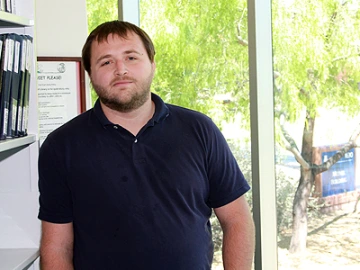Another Wavelength: Johnathan Cushing

This month on Another Wavelength, we meet Johnathan Cushing, a third-year graduate student in the Optical Sciences Ph.D. program, and recipient of the 2015-2016 Outstanding Graduate Student award.
Where are you from?
I was born and raised in the bay area in CA. My home through high school was in the Santa Cruz mountains, and I had more trees than neighbors as a kid. After high school, I joined the Navy so I’ve called a few places home over the years, including South Carolina, Upstate New York and San Diego.
What brought you to study optics?
When I started college after the military I didn’t have a lot of direction. I wanted to be in science and to learn more mathematics than my best friend from high school. My desire for a math-heavy science led me to Physics, which I decided to study at San Diego State University because that’s where my wife went to school. The San Diego State Physics program had an emphasis in Optics option which showed me the light, literally. I then started my research in optics under Dr. Davis at SDSU, and when it came time to apply to graduate school, I decided to continue studying the field.

Who is your hero in science?
I think educating youth about science is one of the most important tasks in education. My hero in Science is Bill Nye the Science Guy. His TV shows are the only reason I ever got interested in math or science as a young kid. My family isn’t very educated and without a TV show like Bill Nye, I never would have found an interest in science, and likely wouldn’t have developed an interest in school.
Describe your research in 20 words or fewer.
I use information science to evaluate imaging systems and optimize their performance.
Describe your research in 200 words or fewer.
I work for Dr. Eric Clarkson on defense imaging projects. We’ve just started working on a project for DARPA called Revolutionary Enhancement of Visibility by Exploiting Active Light-fields (REVEAL). This project was inspired by a paper from MIT which showed that with active imaging you could create an image of an object around a corner. My portion of the project is to look at the information limits of using passive imaging in a similar design scheme.
This example by Nature Video, while not mine, gives a good idea what my research is based on:
Previously I worked on a project for the DHS on anomaly detection in X-rays. For our research I used a simulation framework to analyze the joint tasks limits of X-ray systems. We created several metrics with which you could analyze X-ray system designs and then make design decisions based on the detection and estimation ability of these systems.
Name three neat facts about you.
- I have over 5,000 miles of hiking experience, including a 2,200 mile hike of the Appalachian Trail, a trail that spans from Georgia to Maine along the Appalachian ridge. On the trail I was given the name “Subby” because I used to work on a submarine, although most people assumed I just liked submarine sandwiches.
- For my honeymoon I had my wife, who had no camping experience at all, hike 200 miles of the Camino de Santiago in Spain. I considered this a trial by fire; if the marriage wasn’t going to work out, we would find out right at the start.
- I was awarded the SMART scholarship and will be working for the Navy as a scientist when I finish my schooling.
[Editor's note: Jonathan was recently selected as the 2015-2016 OSC Outstanding Graduate Student. Look for the official announcement, including the Outstanding Undergraduate and Outstanding Teaching Assistant, in an upcoming issue of Watts Up!]
